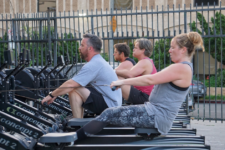
About a week ago, I stumbled upon a local high school baseball practice. It was the junior varsity team. I played on the same field in high school. As a former All-State player who’d become a professional, I figured I’d reminisce a bit, so I stayed and watched.
I don’t watch baseball on TV or follow the sport, so I found myself reflecting on this practice through a unique lens. Based on what I’ve come to obsess about learning, skill development, and the craft of coaching, I sat there watching an abomination. Forget the fact that these players (and the team) were extremely poor performers. The organization of the practice was such that there would be no chance for marked improvement. Based, not on the talent of the group, but of the structure of the practice, I can tell you for a fact that there is a zero percent chance that they could make marked improvement by year’s end.
It’s important to note that the gap between the JV team and the varsity team is significant for not just this group but nearly any school. Much of this disparity isn’t simply physicality either. Sure, the varsity team is older and therefore more physically developed, but their skills are superior. They catch better, they throw better, the run the bases better, and their command of their at bats are of night and day difference.
What, then, must occur for a JV player to become a varsity player? You guessed it. It’s skill development. Without a significantly potent learning environment, these players will never “catch up” to their superiors, especially if the superiors are practicing too! Sadly, these coaches structure the team’s training in a fashion that guarantees a failure to bridge this gap.
How are they failing these kids?
Consider the following scene. One hitter is up to bat, a coach is throwing batting practice from the mound, there’s one hitter on deck, and the rest of the team is scattered out in defensive positions on the field. No one has a chance to practice or learn anything until a pitch is thrown. Sure, the hitter is practicing, but the defense is only practicing if the ball comes their way (please, God!). The batter will get about ten pitches (and only some of them quality pitches worth swinging at) all day. Ten repetitions over the course of two hours isn’t a great use of time. Consider each player gets the ball hit to them six times, which is an exaggeration for some positions, over the course of the practice. That’s ten swings and six defensive opportunities per athlete. What if none of the defensive opportunities for this poor team’s short stop involve a backhanded catch today. This week? This season? With this style of practice, it’s highly likely. A better designed practice could get this athlete and his teammates a hundred reps in a backhand and a hundred reps in the forehand play, for example, in minutes.
Yet, the opportunity for growth is slower than a snail’s pace for this team. If you think about what is transpiring, it’s the same amount of learning that playing a game would give you, except with less focus and less consequences. At this rate, just playing a baseball game would make for better practice. However, playing an entire baseball game is a horrible way to learn the skills of the sport.
Drills expedite learning. What is a drill? A drill is a shrunken down, highly focused piece of a bigger whole. A football drill, for example, isn’t playing a football game. It’s smaller, more deliberate, and allows for tons of repetitions. Think of cones, small focus, and repetition.
A better example of a baseball practice wouldn’t exclude batting practice, but it would get more out of it. Pitches are thrown from a shorter distance to increase accuracy and pitches are thrown more often to keep hitter moving through at a rate ten times faster than this JV team. During the batting practice, two players stand to the side of home plate and hit ground balls to the infielders between pitches. In this instance, the infielders get a ground ball every single pitch regardless as to whether the batter hit the ball to them or not. Base runners get “reads” or mental repetitions to practice reactions to each ball put in play. With a group of base runners at each base exercising simulated predetermined scenarios, there are practice repetitions each and every pitch for them, too. In this instance, every player gets meaningful practice and feedback with every pitch, which is a rate of improvement that this JV team will never catch up to.
The scariest part is that most high performers have figured out how to drive skill development and most under performers have not. This creates an almost insurmountable gap in skill. In this case, the JV will never catch the varsity and, worse yet, the JV will likely explain it away with “they have more talent.”
Since you’re likely not on a JV or a varsity team at this point, what is in this for you? There’s plenty. You likely want to develop skill in something. The gym is an easy place to start. If you want to be a high performer, you’ll need to cherish every rep. Remember, JV and varsity practice for the same amount of time. Yet, practicing like a JV player for a year might leave you worse off than when you started. Practicing like a varsity player might take you to levels you never knew were possible.
Logan Gelbrich
@functionalcoach
4/19/18 WOD
5-5-5-5-5
Push Press
EMOM 12
1. 8 DB Snatches (60/40)
2. 8 Strict Pull Ups
3. 8 Front Rack Lunges (95/65)

